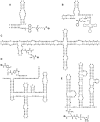The expanding view of RNA and DNA function
- PMID: 25237854
- PMCID: PMC4171699
- DOI: 10.1016/j.chembiol.2014.07.008
The expanding view of RNA and DNA function
Abstract
RNA and DNA are simple linear polymers consisting of only four major types of subunits, and yet these molecules carry out a remarkable diversity of functions in cells and in the laboratory. Each newly discovered function of natural or engineered nucleic acids enforces the view that prior assessments of nucleic acid function were far too narrow and that many more exciting findings are yet to come. This Perspective highlights just a few of the numerous discoveries over the past 20 years pertaining to nucleic acid function, focusing on those that have been of particular interest to chemical biologists. History suggests that there will continue to be many opportunities to engage chemical biologists in the discovery, creation, and manipulation of nucleic acid function in the years to come.
Copyright © 2014 Elsevier Ltd. All rights reserved.
Figures


References
-
- Ameres SL, Zamore PD. Diversifying microRNA sequence and function. Nat Rev Mol Cell Biol. 2013;14:475–488. - PubMed
-
- Bartel DP, Szostak JW. Isolation of new ribozymes from a large pool of random sequences. Science. 1993;261:1411–1418. - PubMed
-
- Beaudry A, DeFoe J, Zinnen S, Burgin A, Beigelman L. In vitro selection of a novel nuclease-resistant RNA phosphodiesterase. Chem Biol. 2000;7:323–334. - PubMed
-
- Blount KF, Breaker RR. Riboswitches as antibacterial drug targets. Nat Biotechnol. 2006;24:1558–1564. - PubMed
Publication types
MeSH terms
Substances
Grants and funding
LinkOut - more resources
Full Text Sources
Other Literature Sources
Miscellaneous

